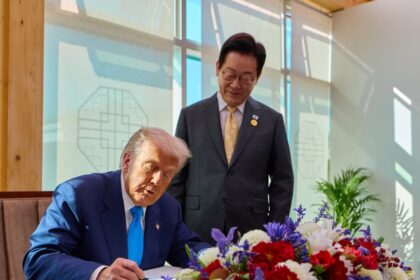A shifting center of gravity in science
China is moving toward parity with the United States in research leadership by a measure that focuses on who guides scientific work, not just how much is published. A large study of almost six million papers found that China based scientists directed 45 percent of joint US China publications in 2023, up from 30 percent in 2010. If current trends continue, the two countries are projected to split leadership roles evenly around 2027 or 2028. The analysis used machine learning to read contribution statements and authorship data to infer which researchers led a project, offering a view of influence that goes beyond raw publication counts or headline citation totals.
- A shifting center of gravity in science
- What leadership in research really means
- From collaboration to competition: the US China trend line
- Talent flows and reverse brain drain
- Where China is gaining ground first
- Money, universities, and the scale effect
- Collaboration in a decoupling era
- What could change the trajectory
- Key Points
The shift matters because leadership signals who sets questions, designs methods, secures resources, and steers collaborations. It suggests that China is not only producing scientific output, it is increasingly organizing global research activity. The timing overlaps with growing turbulence inside the US research system, where funding fights, hiring freezes, and periodic layoffs have eroded confidence and invited recruitment by foreign institutions. In many crucial fields, from artificial intelligence to semiconductors and advanced materials, the study’s modeling indicates China could reach leadership parity with the US before 2030.
The same modeling explored what happens if US China scientific ties weaken further. In a decoupling scenario, China’s global leader share rises because Chinese scientists are more likely to lead collaborations with European and other partners than with US counterparts. Beijing has also spent heavily to expand international education under the Belt and Road Initiative, strengthening networks that feed research partnerships. Since 2012, it has allocated about 33.3 billion yuan to educate foreign students, mainly from Africa and South Asia. By 2018, nearly half of all international students in China came from these regions, and Chinese researchers now lead most collaborations with many Belt and Road participants.
What leadership in research really means
Authorship conventions differ across disciplines, but leadership often shows up in key roles such as corresponding author or senior author, as well as in contribution statements that spell out who conceived experiments, built models, or directed data collection. The study’s machine learning approach combed through these signals to determine who likely led each project. This method is useful because publication volume can be inflated by large consortia or repeated incremental work, while leadership tends to capture intellectual direction and agenda setting.
Multiple independent indicators point to China’s rapid ascent in high impact work. Various ranking methods, including those that track the share of most cited papers worldwide, find China has advanced quickly and, by some measures, already edges the US on impact in several STEM domains. China’s patenting has surged as well, roughly doubling the US patent count in 2021. These markers do not capture everything about quality, but they align with the leadership signal observed in collaborative papers.
From collaboration to competition: the US China trend line
China’s leadership share in US China coauthored papers rose from 30 percent in 2010 to 45 percent in 2023. Extrapolated forward, the lines converge within a few years. The change reflects China’s growing capacity to originate ideas, fund complex projects, and coordinate teams across institutions, while the US still brings unmatched strengths in basic research infrastructure and top laboratories.
When researchers modeled a world with fewer US China links, China’s global leadership share increased, not decreased. Chinese teams already lead many projects with Europe and across Asia, so a partial decoupling shifts activity rather than stopping it. Beijing is also using education to build future collaborations. Funding for scholarships, joint degrees, and visiting fellow programs under the Belt and Road Initiative has created talent pipelines that now connect China’s labs with universities from South Asia to Africa. Those networks show up in publication data as China led collaborations with many of those countries.
Talent flows and reverse brain drain
For decades, the US benefited from a steady inflow of scientists trained abroad, especially from China. That advantage is under pressure. Between 2010 and 2021, nearly 20,000 scientists of Chinese descent who began their careers in the US moved to other countries, with departures rising from 900 in 2010 to 2,621 in 2021. After the launch of the China Initiative in 2018, those departures increased by about 75 percent, and by 2021 roughly two thirds of relocating researchers chose positions in China. Surveyed scientists report anxiety about collaborations and grant applications, with many saying they feel less safe as academic researchers.
In a peer reviewed analysis of these trends, authors writing in the Proceedings of the National Academy of Sciences warned that the climate could erode US capacity to attract and retain top talent.
The United States has long benefitted from the contributions of immigrant scientists, especially those from China. These developments threaten the US’s ability to retain and attract top scientific talent, potentially undermining its global leadership in science and technology.
Marcia McNutt, president of the US National Academy of Sciences, has also cautioned that China’s growth rate in research investment and output is outpacing America’s. She captured the concern in plain terms.
This all suggests to me that there are very worrying trends.
Where China is gaining ground first
The leadership shift is most visible in technology areas that governments consider strategic. The study tied to US metrics for critical technologies indicates that in eight of eleven priority fields designated by the National Science Foundation, Chinese researchers are on track to reach leadership parity with the US before 2030. That does not mean China will dominate commercial markets across the board, but it signals strength in setting research agendas and publishing high impact studies.
AI and semiconductors
China has expanded its footprint in core AI research, from machine learning architectures to computer vision and natural language processing. Many of these papers involve large interdisciplinary teams and compute heavy experimentation. On semiconductors, China faces barriers in cutting edge manufacturing and access to certain tools, yet Chinese labs are prolific on materials, device physics, and design techniques that underpin future chip generations. Leadership in publications does not guarantee manufacturing leadership, but it influences the direction of the science that makes new chips possible.
Quantum technology
China views quantum as a national priority and has committed large public resources to it, investing around 15 billion US dollars. The country operates the world’s largest quantum communication network, spanning about 12,000 kilometers and extending into space with quantum satellites such as Micius. Chinese groups publish more quantum related papers each year than any other country. While the US retains an edge in some quantum computing patents and private sector development, China is well ahead in quantum communications infrastructure and has integrated public research institutes with state owned enterprises to deploy real world systems.
US industry leaders argue that sustained investment and an integrated research ecosystem are essential to keep pace. One prominent voice put it succinctly.
Sustaining American leadership requires continued investment in basic research.
Biotechnology and health sciences
China has built a broad biotech base supported by generous public funding, research clusters around cities like Shanghai, and strong capabilities in contract research, biomanufacturing, and active pharmaceutical ingredients. Chinese labs are producing more high impact work in genomics, cell therapies, and synthetic biology. Authorities treat genetic data as a strategic resource, limiting external access while expanding domestic datasets that feed AI enhanced analysis. Many Chinese firms still rely on overseas partners and markets for advanced products, and returns can be constrained by domestic pricing policies. Yet the research engine is strong, drawing foreign investment and partners even as geopolitical competition grows.
Public health and medical research intersect with diplomacy through the Health Silk Road, an umbrella for projects in disease surveillance, genomics, and clinical trials that expand China’s scientific presence in emerging regions. The approach is comprehensive, bridging military, civilian, academic, and commercial actors in pursuit of long range capacity.
Energy and materials
Chinese researchers publish widely in materials science, including battery chemistry, catalysts for hydrogen and ammonia, and advanced composites for lighter and stronger structures. The trajectory in energy storage and new energy generation reflects years of steady investment and growing domestic demand for green technology. Moving from lab findings to global products will depend on supply chains, standards, and access to capital, areas where policy choices on all sides matter.
Money, universities, and the scale effect
Funding scale and talent pipelines are central to leadership. In 2021, the US spent about 806 billion US dollars on research and development while China invested about 668 billion. China’s growth rate was roughly twice that of the US, and China now produces far more STEM PhD graduates each year. By 2025, Chinese universities are projected to award around 77,000 STEM doctorates annually compared with about 40,000 in the US. China also employs more researchers than the US and the European Union combined. Those numbers feed into publication and leadership metrics.
High quality publication databases show China widening its lead in contributions to select elite journals. In 2024 data, China topped the table by a sizable margin, while the US share declined, particularly in chemistry and parts of the physical sciences. The US still leads in health sciences and retains first place in biological sciences, but the gap has narrowed as China’s output in these fields grows quickly.
China’s university system has expanded rapidly in both scale and quality. One major global ranking for 2025 lists more Chinese institutions than US institutions for the first time. China also leads by count in several other global rankings that emphasize publication impact. Elite universities such as Tsinghua and Peking have climbed into the top tier, while a broader set of regional universities focus on AI, quantum, biotechnology, new energy technologies, and environmental science. This broad base produces a large pool of graduate researchers and postdoctoral fellows who feed into national labs and industry.
US research remains deep and innovative, but budget uncertainty has become a headwind. Proposed cuts to federal science agencies, including a large reduction at the National Institutes of Health, have created fear of a funding squeeze that private philanthropy is unlikely to offset fully. Policy disputes and changing rules on university governance have also made some campuses less attractive to foreign students and faculty. Combined with heightened scrutiny of cross border collaborations, these factors risk eroding a talent advantage that powered US leadership for generations.
Collaboration in a decoupling era
Export controls on advanced chips and other technologies, along with restrictions on sensitive research areas, are pushing labs to rethink collaborative networks. European governments are tightening screening in some fields while seeking to remain open in others. China has implemented its own export controls and limits on international sharing in designated strategic areas. Collaboration is not ending, it is being rerouted. The leadership modeling in the new study suggests that if US China ties weaken further, China’s leader share in global projects would still rise, since Chinese teams lead more frequently with partners in Europe, South Asia, and other regions.
Education diplomacy plays a role. Since 2012, China has funded large cohorts of international students, particularly from Africa and South Asia. By 2018, close to half of foreign students in China came from these regions, and publication data now show China led collaborations in many Belt and Road countries. These relationships create familiarity, shared training, and repeat partnerships that show up in leadership metrics a few years later.
Standards setting and norms are becoming a new arena of competition. China is working to extend its quantum communication network and to pursue international partnerships, while Western governments focus on trusted supply chains and shared protocols among allies. Fragmented ecosystems can slow diffusion of ideas and create incompatibilities. Strong scientific ties among like minded countries can mitigate that risk, but a sustained drop in cross border collaboration would likely slow progress in fields where scale and diverse expertise are crucial.
What could change the trajectory
Policy choices can shape outcomes on both sides. For the US, several steps would help preserve leadership. Sustained and predictable funding for basic and use inspired research is essential, especially in areas like AI, quantum, clean energy, and advanced materials. Workforce development needs attention across the entire pipeline, from community colleges and apprenticeships to doctoral training. A modern immigration policy that welcomes scientists and reduces visa friction would rebuild the talent magnet. Grant processes can be updated to reduce unnecessary complexity and ease fears that discourage collaborations or applications. Safeguarding research security while maintaining openness to legitimate partnerships would address real risks without draining the US of global talent.
Allied cooperation can add scale where individual countries fall short. Shared testbeds, interoperable standards, and coordinated investment can improve translation from lab findings to commercial systems in quantum, biotech, and clean energy. Confidence building mechanisms, transparent guardrails for sensitive work, and reciprocal data access agreements in low risk domains can help preserve the benefits of open science.
For China, sustaining momentum in high impact research is not the same as dominating global markets. Commercial success depends on trusted supply chains, intellectual property protection, and access to overseas customers and investors. Pricing and reimbursement policies at home affect the capital available for risky innovation in health care. Decisions that support open collaboration in low risk areas, while maintaining clear rules for strategic sectors, would lower friction and accelerate adoption of Chinese research outputs around the world.
Key Points
- China led 45 percent of US China collaborative papers in 2023, up from 30 percent in 2010, and is projected to hit parity with the US by 2027 or 2028.
- The leadership metric uses machine learning to identify who directed a study from contribution statements and authorship roles.
- Modeling shows that a decoupling of US China science would raise China’s global leader share, as Chinese researchers more often lead with partners outside the US.
- China is expected to reach leadership parity with the US before 2030 in eight of eleven critical technology areas tracked by the National Science Foundation.
- China has increased output and impact across AI, semiconductors research, quantum communications, and materials science.
- China’s public investment in quantum technology is around 15 billion US dollars, and it runs a 12,000 kilometer quantum communication network backed by quantum satellites.
- Biotech strengths in China include contract research, active pharmaceutical ingredients, and growing capabilities in genomics and cell therapies, though advanced commercialization still leans on overseas markets.
- US R&D spending was about 806 billion US dollars in 2021 versus China’s 668 billion, with China’s growth rate roughly double that of the US.
- China has widened its lead in contributions to select elite journals, while the US still leads in health sciences and maintains strength in biological sciences.
- Departures of scientists of Chinese descent from the US rose by about 75 percent after 2018, with many citing anxiety about collaborations and grant processes.
- China has invested about 33.3 billion yuan since 2012 to educate foreign students, mainly from Africa and South Asia, reinforcing research networks that support China led collaborations.
- US options to stabilize leadership include sustained funding, talent friendly immigration, streamlined grant rules, and stronger research security with openness for low risk collaborations.












